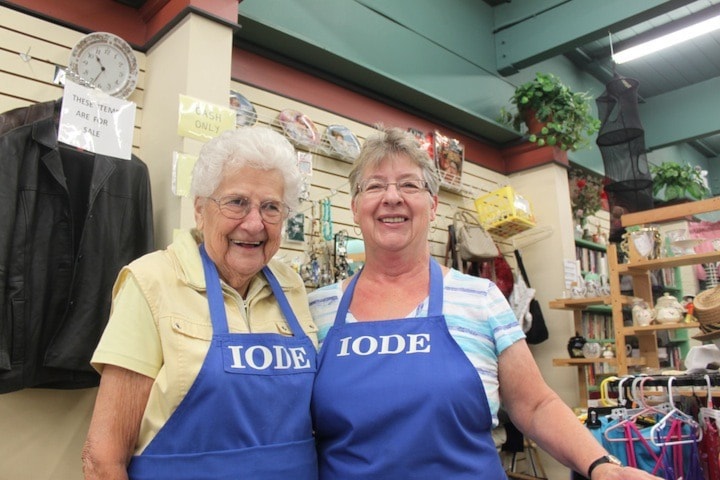The Kokanee Chapter of the IODE celebrates its centennial on Wednesday, September 17 with a party at its thrift store at 670 Baker Street. Here’s a look at some of the charity’s history.
1) Montreal’s Margaret Polson Murray founded the IODE in 1900 to promote patriotism, loyalty and service to others. First known as the Federation of the Daughters of the Empire, it was soon renamed Imperial Order Daughters of the Empire. The first chapter was in Fredericton. The BC provincial chapter was chartered in 1913.
2) A meeting to consider forming a chapter in Nelson was held September 30, 1914 at the home of Helen Cochrane at 1023 Stanley Street. The chapter was formally organized on November 10 and first named Kitchener, presumably after Lord Kitchener, the British war secretary. However, at a meeting on January 13, 1915, the name was changed to Kokanee. The group’s charter was granted a week later. Ethel Dack was the first regent (president). Early meetings were held at the YMCA (today’s Royal Canadian Legion).
3) A junior chapter was formed in Nelson on June 16, 1915, composed of 22 high school students, and named for Major Percy Rigby, killed in France a few months earlier. (There’s a plaque in his honour on the Touchstones building.) It’s not clear how long the chapter lasted, but it was at least through 1918. Dr. Isabelle Arthur was its regent.
4) By 1916, the Kokanee Chapter boasted more than 80 members. Today the group has about 25 members, ranging in age from 65 to 89. New members are welcome — there are no requirements to join. (Call 250-352-9915.) Meetings are held the second Thursday of every month.
5) The Kokanee Chapter is the last remaining in the Kootenays, although there used to be ones in Trail, Castlegar, Grand Forks, and several in East Kootenay. Of the 13 chapters left in BC, Nelson’s is the third oldest, after Duncan (1913) and Salt Spring Island (1914). The newest is in Delta (2006).
6) The IODE opened a tea room on Baker Street in 1915 in a little shop where the LD Cafe and Redfish Grill later stood. Mrs. F.B. Hawthorne recalled: “There we served tea on Wednesdays and Saturdays and in the first 10 weeks made $97.20.”
7) Over the last century, the IODE has donated hundreds of thousands of dollars to causes too numerous to mention. Before the thrift shop opened, fundraisers included fashion shows, dances, teas, and endless raffles.
The Kokanee Chapter raised $8,500 during World War I (about $120,000 today) and $10,000 during World War II ($136,000). It raffled off a house, using the proceeds to help the crews of the HMCS Kokanee and HMCS Kootenay.
In 1922, the chapter raised $3,000 to buy an x-ray machine for the hospital. Between 1988 and 2010, it donated over $100,000 to the Kootenay Lake Hospital Foundation, including $5,000 for the new CT scanner.
The chapter provided milk and cod liver oil to undernourished children as well as glasses and dental care for kids in need. It collected funds to build Mount St. Francis and funded the Nelson Hostel for Aged Men. It bought an ambulance for the Regional District of Central Kootenay. In 1919, it became the first organization in Nelson to award an annual scholarship, which continues to this day.
That barely scratches the surface of its activities.
8) The volunteer-run IODE thrift shop started in 1946 in the Strathcona Hotel, where the library and police station stand today. When the hotel burned in 1955, the thrift shop lost all its contents, but it soon re-opened in a basement at the corner of Baker and Kootenay streets, in the building now home to Dr. Matthew Osepchook and Comishin & Astle.
In 1961, it moved to a new location in the 200 block of Baker Street, then below Shannon’s Fabrics at 560 Baker (downstairs), and finally in 2007 to its present home at 670 Baker. Proceeds are distributed to schools, seniors, arts, sports, and health groups.
9) In 1979, thanks to the initiative of Phyllis Reid, the IODE donated $3,000 (over $9,300 in today’s figures) to buy benches and supplies for a mini-park in the 500 block of Hall Street, although the city was responsible for its landscaping and maintenance. A plaque put up in 1988 identifying it as IODE Park has since gone missing. Renovations to the park are expected to begin soon, the first phase in a revamp of the Hall Street corridor.
10) The Shawn Lamb Archives at Touchstones Nelson have the IODE’s minutes dating back to the beginning as well as scrapbooks from the 1930s onward, from which much of the above was gleaned.
